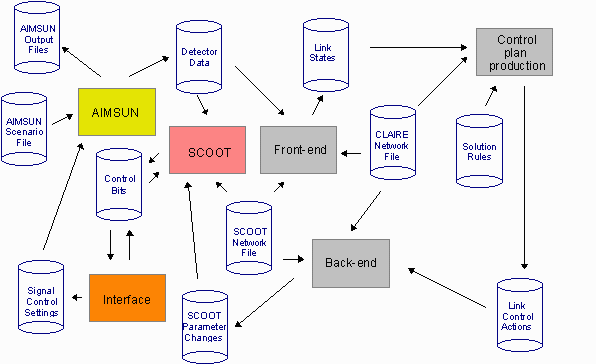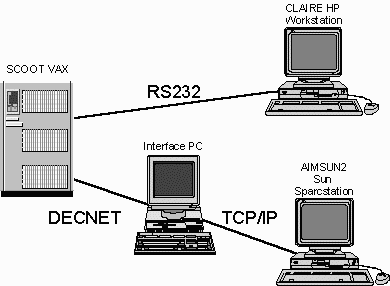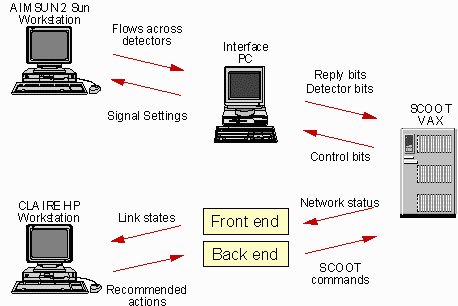
Ken Fox, Roy Clarke and Howard Kirby
Congestion in cities causes fuel consumption to rise sharply, partly because of the longer time it takes to reach a destination, partly because the rate of consumption is much higher at low speeds. Existing traffic control systems do not cope well with heavily congested situations; essentially they were designed to respond to changes in moving traffic, not to the build-up of stopped traffic; and they assume that the supply of road space remains fixed, whereas congestion brings about a reduction in supply.
In a DRIVE I project on artificial intelligence based systems for traffic control, a system called CLAIRE was developed, to provide a strategic congestion-recognition capability lacked by present UTC systems. It is designed to record and to recognise how congestion develops; and with this knowledge to produce recommendations for changes to the current traffic signal settings, such as favour or to hold back different traffic streams. A preliminary evaluation of the system at the conclusion of the study was encouraging; but because that evaluation was undertaken for a road system (in the city of Leicester) that turned out to be not very congested, the outcome is thought to considerably understate CLAIRE's capability. However, the results were sufficiently promising for London to become very interested in its potential.
The CEC SAVE programme is funding a project which will give a clearer demonstration of the efficacy of this system as a method for reducing the energy and efficiency losses caused by congestion. The aim is to evaluate, by means of computer simulation, the reductions in fuel consumption that could be achieved by introducing the CLAIRE supervisory system on top of the SCOOT urban traffic control system in London.
The project's objectives are to set up the evaluation system for using CLAIRE (Bell et al (1991)) as an intelligent supervisor for the SCOOT (Bretherton (1989)) urban traffic control system for an area of London in such a way as to demonstrate the savings in energy that can be achieved. The evaluation requires the assembly of the following software:
A functional description of the whole evaluation tool is shown in the figure below.

AIMSUN2 is used to model the road network and the traffic flowing round it. It requires a Scenario File as input to describe the network geometry and the traffic conditions to be simulated. As cars travel round the simulated network they pass over simulated detectors. The detector data from these vehicle detectors is passed to SCOOT so that it can determine the optimal signal settings which will minimise delay. These signal settings are passed back to AIMSUN2 using control bits via an Interface which translates them appropriately. SCOOT can also use the detector data to determine which links in the network are congested so that this link state information can be passed to CLAIRE. This is performed by a Front-end module. When CLAIRE has been supplied with solution rules for acting on congestion information it can then use this information about congestion within the network to recommend interventions via link control actions if necessary. The interventions have to be translated into appropriate SCOOT parameter changes via a Back-end module. The front-end and back-end modules need to be able to map links in the SCOOT Network model on to the corresponding arcs in the CLAIRE Network model. AIMSUN output files contain data on the fuel consumed during the simulation period and can be examined to determine the effectiveness of the CLAIRE system.

The communications between the different parts of the evaluation tool are as follows. The SCOOT VAX communicates with an interface PC over DECNET, while the interface PC communicates with the AIMSUN2 workstation using TCP/IP. CLAIRE receives congestion indications from SCOOT, and passes recommendations back to SCOOT, over a standard RS-232 line.

AIMSUN2 (Advanced Interactive Microscopic Simulator for Urban and Non- Urban Networks) (Barcelo, Ferrer and Montero (1989), Ferrer and Barcelo 1992)) is a software tool which is able to reproduce the real traffic conditions of any urban network on a computer. It is mainly useful for testing new traffic control systems and management policies without having to implement them on the real traffic network. A new fuel consumption module has been added to AIMSUN2 to allow it to assess the effects of different measures on the fuel consumed. The model assumes that each vehicle is either idling, cruising at a constant speed, accelerating or decelerating. At each time step the state of each vehicle is determined and the model then uses an appropriate formula to calculate the fuel consumption for this state. The program is then able to output the total fuel consumed on each section in the network, during the simulation time interval.
According to Ferreira (1982), the fuel consumption rates for idling, accelerating and decelerating vehicles all have a very simple form. For idling and decelerating vehicles the rate (in ml/s) can be assumed to be constant. For an accelerating vehicle it is given by the formula c1+c2 a v, where c1 and c2 are constants and a and v are the vehicle acceleration and speed respectively.
The following fuel consumption equation (in ml/s), for a cruising vehicle moving at speed v (km/h), has been determined by Akcelic (1982). It contains three constants; k1, k2 and vm, which need to be determined empirically for each vehicle type. vm is the speed at which the fuel consumed per km travelled is a minimum. Typically this is around 50 km/h. The rate of use of fuel over time is given by:

The UK Department of Transport (1994) provide fuel consumption figures for all new cars. Amongst the figures given are the fuel consumption in litres per 100km, for vehicles travelling at speeds of 90km/h and 120km/h. These figures can be used to determine the constants k1 and k2 above. It is straightforward to show that if R1 and R2 are the fuel consumption rates in litres per 100km for a vehicle travelling at a constant speed of either v1 or v2 respectively, then two values of dF/dt in ml/s can be calculated by converting R1 and R2 to units of ml/s by using the following equation:

Substituting these two values into Akcelic's equation gives two equations in two unknowns (k1 and k2) which are straightforward to solve to give the following expressions:


If v1=90 km/h, v2=120 km/h then these reduce to:


A network has been chosen for the evaluation. It is the Kingston region in South West London, which contains thirty signalised intersections.
All the data required for this network has been collected and has been entered into both AIMSUN2 and CLAIRE. For CLAIRE, congestion scenarios have been identified and appropriate holding and favouring actions determined.
A very powerful simulation tool is being developed which allows realistic estimates to be made of the effects of using the CLAIRE intelligent supervisor to reduce congestion in a network controlled by the SCOOT urban traffic control system.
AKCELIK (1982), Progress in Fuel Consumption Modelling for Urban Traffic Management, Australian Road Research Board Research Report ARR No. 124.
BARCELO, J., FERRER J.L. AND MONTERO L. (1989). AIMSUN: Advanced Interactive Microscopic Simulator for Urban Networks. Vol I: System Description, and Vol II: Users Manual. Departamento de Estad'stica e Investigacion Operativa. Facultad de Informatica. Universidad Politecnica de Cataluna.
BELL, M.C., SCEMAMA, G. AND IBBETSON, L.J. (1991) CLAIRE: an expert system for congestion management. In Advanced Telematics in Road Transport, Proceedings of the DRIVE Conference, held in Brussels, February 1991. Elsevier, Amsterdam, Vol 1, pp 596-614.
BRETHERTON, R.D. (1989) SCOOT Urban traffic control system - Philosophy and Evaluation. IFAC Symposium on Control. Communications in Transportation. September 1989, pp 237-239.
FERREIRA, L.J.A. (1982), Car Fuel Consumption in Urban Traffic. The Results of a Survey in Leeds using Instrumented Vehicles. ITS Working Paper No. 162, Institute for Transport Studies, University of Leeds.
FERRER, J.L. AND BARCELO, J (1992). Modelos microscopicos de simulacion de sistemas de guiado de veh'culos. Research Report. Departamento de Estad'stica e Investigacion Operativa. Facultad de Informatica. Universidad Politecnica de Cataluna.
DEPARTMENT OF TRANSPORT (1994), New Car Fuel Consumption : the official figures December 1994, UK DoT.